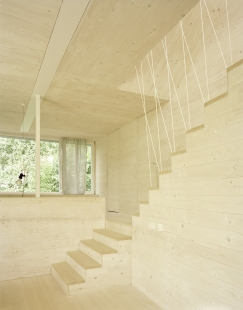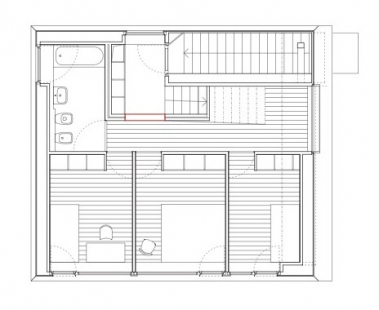
JustK

This 365 square-metre site is located in Tübingen; on a south-facing slope with a view over the city and of Tübingen castle. The 1960s development plan stipulates a specific position for the house on the site as well as “insertion into the surroundings” according to §34 of the Federal Building Code. The client commissioned the design of a family home that would provide passively heated living space for two adults and four children. Use of energy efficient passive house technology, natural application of materials and prudent use of the resources at hand, make the building sustainable. The potential adaptation of the house to the family’s living situation was an important aspect thereof.
The question is, what is “good” living space? What defines it and what does one really need? These issues guided us in our approach to the layout of the house, which has been efficiently designed to optimally deliver maximum use of space, functionality and flexibility. We strove to create outstanding spatial quality using a minimum of materials. Imaginative overlapping of spatial areas and uses were designed to give the inhabitants a feeling of spaciousness, manifold atmospheres and various realms of possibility—despite minimised living area. The parameters of a limited-sized site, distance spacing regulations, and ample living space for six people, led the building to grow upwards in tower-like fashion. JustK relates to the surrounding grey 1920s tuff buildings in a contemporary manner through its compact envelope and defined roof volume.
The swing of its hipped roof and its multiply-kinked shape derive on the one hand from a desire to create maximum spatial volume with minimum distance spacing, which the 70° angle facilitates in adherence to state building regu- lations, and on the other hand from a request by the neighbours to keep the view of Tübingen Castle unimpeded—under which conditions they sold the site.
Prefabrication, Structure, Surface Treatment he structural physical demands on passive houses, their short construction period as well as sustainability considerations, all culminated in a decision to build this house in solid wood, optimally using the potentials of prefabrication. The whole building consists of 136 elements, which were fabricated with notches for carpentry and joinery as well as with drill holes and grooves for installation of the electrics.
Wood is the main material to be used consistently throughout the structure and interior surfaces; as a renewable raw material it was chosen not least for its favourable energy balance. To keep costs down, the wooden surfaces in the common rooms have been designed in “refined shell construction.” The industrial surface of these cross-layered wooden elements have been sanded down, bucked and soaped to preserve the light character of the wood.
The question is, what is “good” living space? What defines it and what does one really need? These issues guided us in our approach to the layout of the house, which has been efficiently designed to optimally deliver maximum use of space, functionality and flexibility. We strove to create outstanding spatial quality using a minimum of materials. Imaginative overlapping of spatial areas and uses were designed to give the inhabitants a feeling of spaciousness, manifold atmospheres and various realms of possibility—despite minimised living area. The parameters of a limited-sized site, distance spacing regulations, and ample living space for six people, led the building to grow upwards in tower-like fashion. JustK relates to the surrounding grey 1920s tuff buildings in a contemporary manner through its compact envelope and defined roof volume.
The swing of its hipped roof and its multiply-kinked shape derive on the one hand from a desire to create maximum spatial volume with minimum distance spacing, which the 70° angle facilitates in adherence to state building regu- lations, and on the other hand from a request by the neighbours to keep the view of Tübingen Castle unimpeded—under which conditions they sold the site.
Prefabrication, Structure, Surface Treatment he structural physical demands on passive houses, their short construction period as well as sustainability considerations, all culminated in a decision to build this house in solid wood, optimally using the potentials of prefabrication. The whole building consists of 136 elements, which were fabricated with notches for carpentry and joinery as well as with drill holes and grooves for installation of the electrics.
Wood is the main material to be used consistently throughout the structure and interior surfaces; as a renewable raw material it was chosen not least for its favourable energy balance. To keep costs down, the wooden surfaces in the common rooms have been designed in “refined shell construction.” The industrial surface of these cross-layered wooden elements have been sanded down, bucked and soaped to preserve the light character of the wood.
AMUNT
0 comments
add comment




































